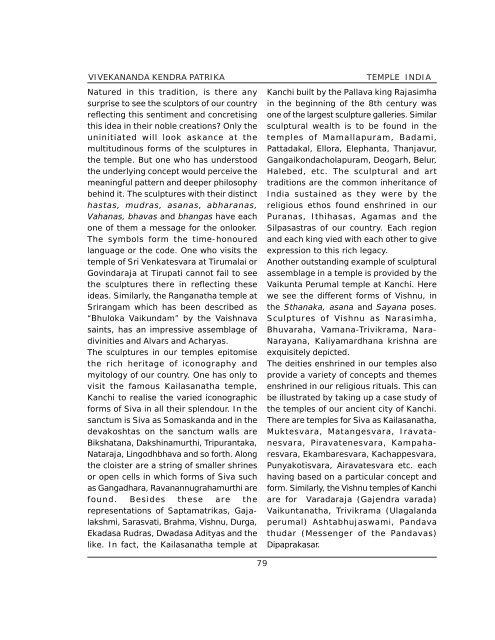Temples In India-1.pdf - Vivekananda Kendra Prakashan
Temples In India-1.pdf - Vivekananda Kendra Prakashan
Temples In India-1.pdf - Vivekananda Kendra Prakashan
Create successful ePaper yourself
Turn your PDF publications into a flip-book with our unique Google optimized e-Paper software.
VIVEKANANDA KENDRA PATRIKANatured in this tradition, is there anysurprise to see the sculptors of our countryreflecting this sentiment and concretisingthis idea in their noble creations? Only theuninitiated will look askance at themultitudinous forms of the sculptures inthe temple. But one who has understoodthe underlying concept would perceive themeaningful pattern and deeper philosophybehind it. The sculptures with their distincthastas, mudras, asanas, abharanas,Vahanas, bhavas and bhangas have eachone of them a message for the onlooker.The symbols form the time-honouredlanguage or the code. One who visits thetemple of Sri Venkatesvara at Tirumalai orGovindaraja at Tirupati cannot fail to seethe sculptures there in reflecting theseideas. Similarly, the Ranganatha temple atSrirangam which has been described as“Bhuloka Vaikundam” by the Vaishnavasaints, has an impressive assemblage ofdivinities and Alvars and Acharyas.The sculptures in our temples epitomisethe rich heritage of iconography andmyitology of our country. One has only tovisit the famous Kailasanatha temple,Kanchi to realise the varied iconographicforms of Siva in all their splendour. <strong>In</strong> thesanctum is Siva as Somaskanda and in thedevakoshtas on the sanctum walls areBikshatana, Dakshinamurthi, Tripurantaka,Nataraja, Lingodhbhava and so forth. Alongthe cloister are a string of smaller shrinesor open cells in which forms of Siva suchas Gangadhara, Ravanannugrahamurthi arefound. Besides these are therepresentations of Saptamatrikas, Gajalakshmi,Sarasvati, Brahma, Vishnu, Durga,Ekadasa Rudras, Dwadasa Adityas and thelike. <strong>In</strong> fact, the Kailasanatha temple atTEMPLE INDIAKanchi built by the Pallava king Rajasimhain the beginning of the 8th century wasone of the largest sculpture galleries. Similarsculptural wealth is to be found in thetemples of Mamallapuram, Badami,Pattadakal, Ellora, Elephanta, Thanjavur,Gangaikondacholapuram, Deogarh, Belur,Halebed, etc. The sculptural and arttraditions are the common inheritance of<strong>In</strong>dia sustained as they were by thereligious ethos found enshrined in ourPuranas, Ithihasas, Agamas and theSilpasastras of our country. Each regionand each king vied with each other to giveexpression to this rich legacy.Another outstanding example of sculpturalassemblage in a temple is provided by theVaikunta Perumal temple at Kanchi. Herewe see the different forms of Vishnu, inthe Sthanaka, asana and Sayana poses.Sculptures of Vishnu as Narasimha,Bhuvaraha, Vamana-Trivikrama, Nara-Narayana, Kaliyamardhana krishna areexquisitely depicted.The deities enshrined in our temples alsoprovide a variety of concepts and themesenshrined in our religious rituals. This canbe illustrated by taking up a case study ofthe temples of our ancient city of Kanchi.There are temples for Siva as Kailasanatha,Muktesvara, Matangesvara, Iravatanesvara,Piravatenesvara, Kampaharesvara,Ekambaresvara, Kachappesvara,Punyakotisvara, Airavatesvara etc. eachhaving based on a particular concept andform. Similarly, the Vishnu temples of Kanchiare for Varadaraja (Gajendra varada)Vaikuntanatha, Trivikrama (Ulagalandaperumal) Ashtabhujaswami, Pandavathudar (Messenger of the Pandavas)Dipaprakasar.79
















